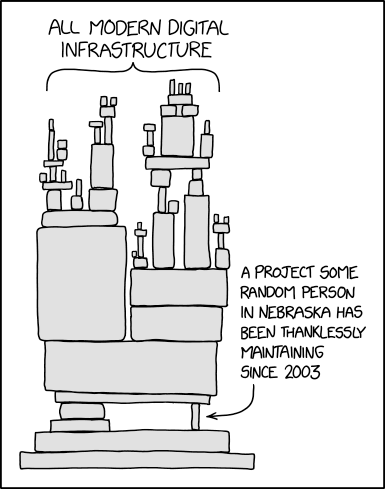Top Tips for a Strong Zero Trust Architecture
A zero trust architecture reduces a network's attack surface and lowers the risk of a data breach. Here are some tips when implementing such an architecture.Worth Exploring: BGP from Theory to Practice
My good friend Tiziano Tofoni finally created an English version of his evergreen classic BGP from theory to practice with co-authors Antonio Prado and Flavio Luciani.
I had the Italian version of the book since the days I was running SDN workshops with Tiziano in Rome, and it’s really nice to see they finally decided to address a wider market.
Also, you know what would go well with that book? Free open-source BGP configuration labs of course 😉
Worth Exploring: BGP from Theory to Practice
My good friend Tiziano Tofoni finally created an English version of his evergreen classic BGP from theory to practice with co-authors Antonio Prado and Flavio Luciani.
I had the Italian version of the book since the days I was running SDN workshops with Tiziano in Rome, and it’s really nice to see they finally decided to address a wider market.
Also, you know what would go well with that book? Free open-source BGP configuration labs of course 😉
Forwarding BUM Frames in VXLAN Network With Multicast in Underlay
There are two main methods that can be used to forward broadcast, unknown unicast, and multicast (BUM) frames in a VXLAN network:
- Ingress replication.
- Multicast in underlay.
In this post, we take a detailed look at how multicast can be used to forward BUM frames by running multicast in the underlay. We are using the topology from my Building a VXLAN Lab Using Nexus9000v post. The Spine switches are configured using the Nexus feature Anycast RP. That is, no MSDP is used between the RPs. To be able to forward broadcast frames such as ARP in our topology, the following is required:
- The VTEPs must signal that they want to join the shared tree for 239.0.0.1 (to receive multicast) using a PIM Join.
- The VTEPs must signal that they intend to send multicast for 239.0.0.1 on the source tree using a PIM Register.
- The RPs must share information about the sources that they know of by forwarding PIM Register messages.
- The VTEP must encapsulate ARP packets in VXLAN and forward in the underlay using multicast.
The Leaf switches have the following configuration to enable multicast:
ip pim rp-address 192.0.2.255 group-list 224. Continue reading
Hedge 200: Automation with Ethan Banks
We’ve been on a long streak of discussions about automation, why it works, why it isn’t working, and what the networking industry can do about it. For this episode, we’re joined by the indubitable Ethan Banks. If you don’t think there’s anything left to say, you’ve not yet listened to Ethan!
Heavy Networking 707: Getting Real With Selector’s AIOps (Sponsored)
AI and machine learning are finally being applied to networking in meaningful ways. On today's sponsored show we talk with Selector about its AIOps platform, which ingests networking logs, flows, configurations, SNMP, and other telemetry to detect patterns, spot problems, and provide contextual insights to help network engineers do their jobs better. We speak with Selector about what it is, how it works, and concrete use cases.
The post Heavy Networking 707: Getting Real With Selector’s AIOps (Sponsored) appeared first on Packet Pushers.
HN707: Getting Real With Selector’s AIOps (Sponsored)
AI and machine learning are finally being applied to networking in meaningful ways. On today's sponsored show we talk with Selector about its AIOps platform, which ingests networking logs, flows, configurations, SNMP, and other telemetry to detect patterns, spot problems, and provide contextual insights to help network engineers do their jobs better. We speak with Selector about what it is, how it works, and concrete use cases.Early Data-Link Layer Addressing
After covering the theoretical part of network addressing (part 2, part 3), let’s go into some practical examples. I’ll start with data link layer and then move on to networking and higher layers.
The earliest data link implementations that were not point-to-point links were multi-drop links and I mentioned them in the networking challenges part of the webinar. Initially, we implemented multi-drop links with modems, but even today you can see multi-drop in satellite communications, Wi-Fi, or in cable modems.
Early Data-Link Layer Addressing
After covering the theoretical part of network addressing (part 2, part 3), let’s go into some practical examples. I’ll start with data link layer and then move on to networking and higher layers.
The earliest data link implementations that were not point-to-point links were multi-drop links and I mentioned them in the networking challenges part of the webinar. Initially, we implemented multi-drop links with modems, but even today you can see multi-drop in satellite communications, Wi-Fi, or in cable modems.
Top Questions for Wireless Operators Worldwide on Network Sunsettings
Plan to expand? Prepare for country-specific plans to sunset 2G and 3G nets for 5G to rise.Does Automation Require Reengineering?

During Networking Field Day 33 this week we had a great presentation from Graphiant around their solution. While the presentation was great you should definitely check out the videos linked above, Ali Shaikh said something in one of the sessions that resonated with me quite a bit:
Automation of an existing system doesn’t change the system.
Seems simple, right? It belies a major issue we’re seeing with automation. Making the existing stuff run faster doesn’t actually fix our issues. It just makes them less visible.
Rapid Rattletraps
Most systems don’t work according to plan. They’re an accumulation of years of work that doesn’t always fit well together. For instance, the classic XKCD comic:

When it comes to automation, the idea is that we want to make things run faster and reduce the likelihood of error. What we don’t talk about is how each individual system has its own quirks and may not even be a good candidate for automation at any point. Automation is all about making things work without intervention. It’s also dependent on making sure the process you’re trying to automate is well-documented and repeatable in the first place.
How many times have you seen or heard of Continue reading
HS058 Are We Pausing the Technology Cycle
Today we debate its technoloyg is reaching a stable phase. Greg argues that we are in a period of stability, citing resistance to change and a slowdown in advancements. Johna believes that the rise of quantum computing and AI will lead to significant disruptions. They also discuss the future of AI and quantum computing, with Johna predicting a transformative impact by 2026, while Greg suggests a slower adoption due to existing heavy investments in technology.
The post HS058 Are We Pausing the Technology Cycle appeared first on Packet Pushers.